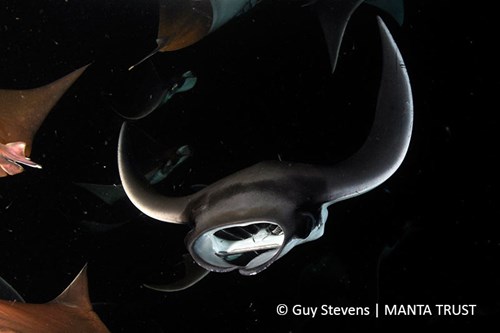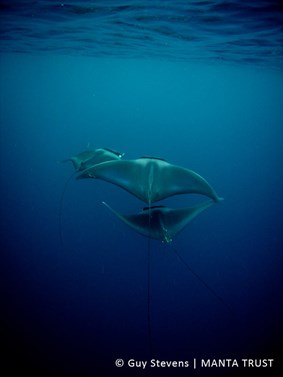Devil rays gain protection at CITES!
30/12/2016 in Conservation

There has been good news for the devil rays recently, as delegates from all over the world agree to protect all 9 species under Appendix II of the Convention on the International Trade in Endangered Species (CITES).
Devil rays, and their close relatives, the Manta rays, are under huge fishing pressure from target and bycatch fisheries supplying the international demand for their gill plates, which are used as a pseudo-remedy in some traditional medicines. This trade is unsustainable however, as devil rays reproduce only very slowly, and so are unable to recover from exploitation. Under the new regulations, all 183 countries which are signatories to CITES will now be required to regulate and monitor trade in all devil ray parts.

Above: The Manta Trust team just before the vote
Thanks to a travel grant from the Fisheries Society of the British Isles, I was lucky enough to attend the recent CITES conference in Johannesburg alongside colleagues from The Manta Trust and TRACE Wildlife Forensics Network, and so witness first hand all the discussions and arguments on both sides of the debate regarding trade in all wildlife products, from elephant ivory to shark fins. This was especially useful, as my PhD at Bangor University and RZSS is working towards developing genetic tools for the conservation of Manta and devil rays. This includes traceability tools to identify a ray, or any of its parts down to species and regional level for monitoring and enforcement of regulations such as CITES.
 The conference was a truly fascinating and exhausting experience. We would often find ourselves running from the main session upstairs, in order to make it to a particularly interesting side event, and then dashing back for a meeting in the exhibition, and somehow remembering to eat in the meantime! It was really beneficial to be able to speak with delegates from all over the world on the frontline against the illegal wildlife trade about the threats facing the devil rays, and all the research being carried out to effectively inform their conservation.
The conference was a truly fascinating and exhausting experience. We would often find ourselves running from the main session upstairs, in order to make it to a particularly interesting side event, and then dashing back for a meeting in the exhibition, and somehow remembering to eat in the meantime! It was really beneficial to be able to speak with delegates from all over the world on the frontline against the illegal wildlife trade about the threats facing the devil rays, and all the research being carried out to effectively inform their conservation.
The fact that the devil rays are now to be regulated under CITES is excellent news. It is not just beneficial for the devils – but Mantas too. Mantas were listed in 2013, and so trade in Manta parts has been regulated for the last few years. However, due to difficulties identifying between gill plates of different species, specialist training was required to distinguish between listed manta parts, and unregulated devil ray parts. In light of the recent resolutions for the devil rays, all gill plates are now regulated, and so it is no longer possible to hide manta gill plates among devil ray gill plates in trade. Not only that, but the new listings allow for more stringent and standardised monitoring of the trade, and is therefore a massive step forward for marine conservation!
Jane
Jane Hosegood
RZSS WildGenes PhD Student
 Help support our work
Help support our work
The Royal Zoological Society of Scotland (RZSS) is an independent charity. We receive no direct government funding and rely on the generosity of supporters just like you.
Find out how you can help support our conservation work in projects like those described in this blog, as well as many others, via the link below:
Featured Articles

An update from the Budongo Forest
19/04/2024 in Conservation

Edinburgh Zoo named best zoo in Scotland
15/04/2024 in Edinburgh Zoo

























Follow EZ